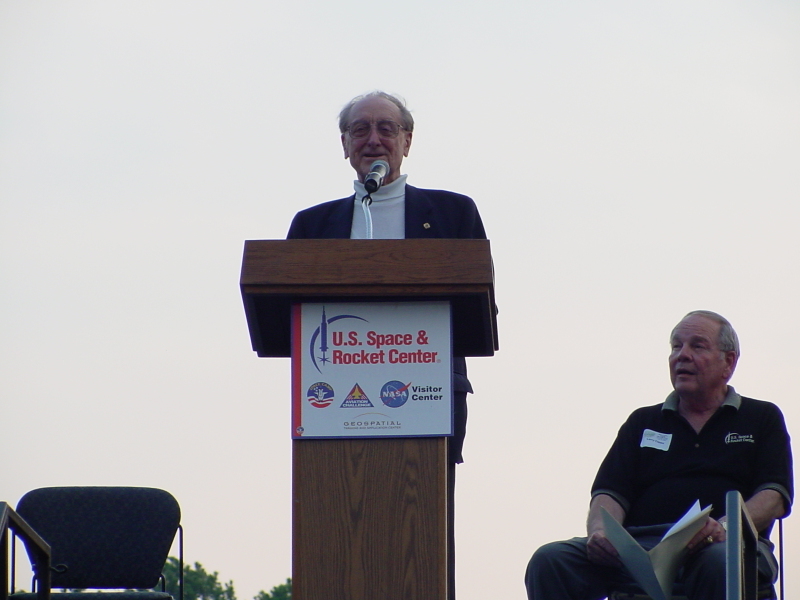| Prev |
heroicrelics.org USSRC Saturn/Apollo Reunions Site Index Third Annual Saturn/Apollo Reunion (2006) Gallery |
Next |
Dr. George Mueller
Dr. George Mueller then addressed the crowd:
Thank you ever so much. It's a tremendous pleasure for me to be with you all this evening to celebrate the groundbreaking for the new Saturn V exhibit hall. I was amazed at how much money you raised and also surprised by how much more you had to go [laughter]. But it only takes about a thousand people to contribute $1,000 and you'll be over the top.
The Apollo program has been characterized as the greatest technological feat in the history of civilization. Its accomplishment required the dedication and the efforts of some 400,000 people in all the parts of the US government and its contractor spectrum, and to the vision enunciated by President Kennedy; the creation of an entirely new class of space vehicles; the development of the new science of the moon; and the understanding of man's ability to live and work in space.
I think it's appropriate on this occasion to remember the leaders who made the Saturn V a reality. Here at Marshall Space Flight Center, there was Wernher von Braun, Eberhard Rees, Lee James, and Arthur Rudolf who lead the Saturn team. And then there were all the support people like Konnie [Konrad Dannenberg] and ... the name escapes me ... he's an old friend, Stuhliger, Ernst Stuhliger; and at KSC, at the other end of this device, there was Kurt Debus, Rocco Petrone, David Jones, and Rod Middleton, who led the launch team. And then there was the leader of leaders at headquarters, Sam Philips. General Philips was the man who pulled it all together and made it real.
But, it was 250,000 people who made up the teams they led, consisting of many of you here this evening, who really created the Saturn V. I salute you all.
Perhaps the greatest praise that I can give to you who were part of that team is to say that you have proven with the ease that comes of long, hard work, what we all instinctively knew and, working together proved, in 1969: that man can successfully travel to another another planet, live, work there, and return safely.
But we cannot continue to live in the past. Some of you will remember our grand vision, some forty years ago, of a space transportation system that would make travel to the moon and Mars routine. It would establish a colony and, with one of its missions, the provisions and materials for the establishment of outposts and colonies on Mars.
As I turned the earth at this groundbreaking for the new crypt for Saturn V, this magnificent machine that took us to the moon, I could not help but remember that this vehicle, or one like it, was one of the key components of that vision of the future. Sadly, we have lost the means to reproduce it today. It is ironic that, for the amounts of funds we have spent on space activities in the past thirty years, we could have implemented that grand vision. We could today have a colony on the moon and could have outposts on Mars.
But today we have a president who has embraced that vision; a president who has said we will meet our obligations to our partners on the International Space Station with a new generation of vehicles; a president who has committed the nation to develop a new exploration system by 2020, capable of establishing a lunar base; and a president who has established a goal of using the moon as a stepping stone to Mars.
If we, as a nation, will support that vision, then I might live to see the first man on Mars.
Thank you all very much.
Larry Capps then introduced the next speaker, Dick Gordon:
Astronaut Richard F. Gordon Jr. was born in Seattle, Washington, and received a Bachelor of Science degree from the University of Washington. NASA selected Dick as an astronaut in 1963, and he made his first space flight as pilot on September 12th 1966 on Gemini 11. On November 14th 1969, Dick was back in space on the Apollo 12 moon mission. In 1971, Dick became the chief of advanced programs for the astronaut office. A year later, he retired from NASA and the Navy to become executive vice president of the New Orleans Saints professional football team. That's quite a step, Dick [chuckles]. Thank you, Dick, for being here tonight.

| Time picture taken | Sat Jul 15 19:18:17 2006 |
| File name | dsc18697.jpg |
| Location picture taken | Rocket Park US Space & Rocket Center Huntsville, AL |
| Prev | Third Annual Saturn/Apollo Reunion (2006) Gallery | Next |